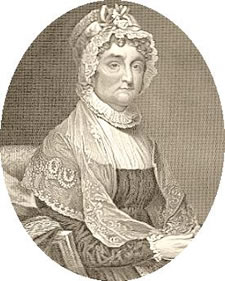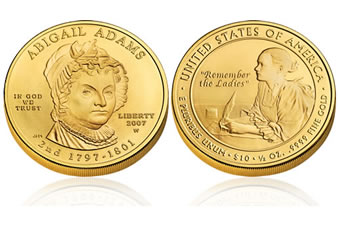Abigail Adams First Spouse Gold Coins
Abigail Adams First Spouse Gold Coins were introduced by the United States Mint on June 19, 2007. The coins are number two in the series to honor American "First Spouses" and right behind the Martha Washington First Spouse Coins, although the timing was such that the Mint happened to release both on the same day, and each of the four coins sold out within hours.
Exactly like the other coins in the series, the $10 Abigail Adams First Spouse Coins were struck in one-half ounce 24-karat gold and minted in proof and uncirculated versions for the $429.95 and $410.95, respectively, for a total combined limited mintage of 40,000.
These coins are currently selling in the secondary market for more than what what the US Mint charged. (See Abigail Adams Gold Coins on eBay.)
Abigail’s First Spouse Gold Coin contains a portrait of her on the Obverse or heads side, designed and sculpted by Joseph Menna. The Reverse was designed by Thomas Cleveland and sculpted by Phebe Hemphill. It depicts a younger Abigail writing to her husband as he attended the Second Continental Congress, and her famous words "remember the ladies". (See large Abigail Adams First Spouse Coin images.)
Abigail Adams Biography (1744-1818)
 The second "First Lady" of the United States of America, Abigail Adams would prove to be a force of power in her husband’s administration. She is remembered not only for that influence on political events of the time, but also for her long-standing habit of writing to her husband which would provide historians with important details of both the revolutionary time of the United States and of their marital relationship.
The second "First Lady" of the United States of America, Abigail Adams would prove to be a force of power in her husband’s administration. She is remembered not only for that influence on political events of the time, but also for her long-standing habit of writing to her husband which would provide historians with important details of both the revolutionary time of the United States and of their marital relationship.
Abigail Smith was born on November 11, 1744 into a well respected minister’s family. Not unusual for young women of this era, Abigail did not receive formal schooling, but was taught at home by her mother. School would have probably been out of the question for her anyway since she was plagued with poor health for most of her childhood.
Sickness did not prevent her from becoming an avid reader and she became quite versed in the fields of Shakespeare, theology, ancient history, philosophy, law and government. By the time she reached adulthood, Abigail was considered to be quite learned. With this knowledge, she grew to have quite definite ideas about controversial subjects such as women’s rights.
At the age of nineteen, Abigail married a young Harvard trained lawyer named John Adams. As John’s success continued, he attained the post of circuit judge, which would be the start of many separations Abigail and he would endure. This prompted the couple to start a lifelong correspondence that would result in a vast collection of their personal thoughts, as well as a history of the current events of the time. The letters could not cure the loneliness, however, and in a 1773 letter she wrote to John:
"Alas! How many snow banks divide thee and me….”
No strangers to separation, it was not surprising that Abigail remained home while her husband fulfilled his duty as delegate to the First and Second Continental Congresses. It was while John attended the Second Continental Congress and was deliberating on the Declaration of Independence that Abigail affirmed her belief in women’s rights when she wrote to John:
“…remember the ladies, and be more generous and favorable to them than your ancestors. Do not put such unlimited power into the hands of the Husbands. Remember all Men would be tyrants if they could. If particular care and attention is not paid to the Ladies we are determined to foment a Rebellion, and will not hold ourselves bound by any Laws in which we have no voice, or Representation."
Post Revolutionary War assignments separated Abigail and John again as he was dispatched on diplomatic duty twice to Europe. On the second posting, Abigail was able to join John, and participated in the many ceremonial functions required of a statesman.
John desired to become the first President of the United States, but losing in the Electoral College to George Washington, he instead became the first Vice President. He served in this position for two terms, finally becoming President following Washington’s retirement. As the second First Lady, Abigail brought a deep sense of formality to all state functions, which she copied from the European ceremonies she had attended during John’s diplomatic duty years before.
The Adams were the first family to actually live in what would come to be known as the White House. At that time, Washington D.C. (originally called "Federal City") was still in the infancy of its construction. Still obliged to run the household even as First Lady, Abigail could be found to hang her laundry in the unfinished East Room to dry.
Domestic duties did not prevent her from promoting her own personal opinions and objectives, not only with her husband, but with the public. She was not afraid to write and to allow her letters to be published. Opponents to her philosophy and to the power she wielded as confidante to the leader of the country called her "Mrs. President."
After losing the re-election to Thomas Jefferson, the Adams returned to their home in Massachusetts. John and Abigail continued to foster strong political views in their family, and although she would not live to see it, their son, John Quincy Adams, would one day become the sixth President of the United States.
Additional Resources
- Abigail Adams First Spouse Coin images
- Abigail Adams First Spouse Medal images
- Abigail Adams First Spouse Coin Designs
- US Mint press announcement
- US Mint First Spouse Program
- White House Biography of Abigail Adams
- First Spouse Gold Coin Price Guide

